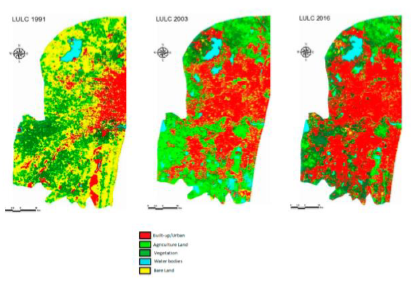Vertical Greening: A Decisive Approach to Mitigate the Rising Temperature in Chennai Due to Land use Change and Land cover Change
Keywords:
loss of vegetation, Urban sprawl, urban temperature, Vertical greeningAbstract
The environment's ecological balance has been completely disrupted as a result of the fast urbanization that has been taking place over time. The volume of vegetation has been steadily declining as a result of various development operations. Today's changing patterns in urban sprawl and the diverse character of the urban vegetation cover make it difficult to monitor the loss of vegetation cover. To satisfy human needs, buildings are being built at an alarming rate, endangering the environment and resulting in the rise of urban temperature. Bringing back the lost greenery is very important to provide a comfortable environment by lowering the urban temperature. However, as the land has been taken up for construction activities, replanting all trees on the ground is impossible due to a shortage of space and growing trees requires lots of time. To address the above issue, Vertical greening is a feasible and sustainable approach to bringing back the lost greenery on the vertical surface of the buildings. To take full advantage of a Vertical Greening System (VGS) in terms of thermal performance in a hot and humid climate like Chennai, a research series was conducted to establish the need for vertical greening due to land use change, to widen the knowledge on vertical greening, analyze on different types of VGS to come out with an efficient VGS for hot and humid climate along with exploring the efficiency of native species in reducing the air temperature. This paper establishes the need for vertical greening due to land use and land cover change in Chennai.
Downloads
References
Jeganathan, Anushiya, Ramachandran, Andimuthu, Palanivelu, Kandasamy, “Challenges in Chennai City to Cope with Changing Climate,” European Journal of Climate Change. vol. 3, pp. 33-43, 2021. 10.34154/2021-EJCC-0017/euraass.
Deepak Mathur, N. K. V. . (2022). Analysis & Prediction of Road Accident Data for NH-19/44. International Journal on Recent Technologies in Mechanical and Electrical Engineering, 9(2), 13–33. https://doi.org/10.17762/ijrmee.v9i2.366
Jeganathan, Anushiya, and Ramachandran, Andimuthu, “Temperature trends of Chennai City, India,” Theoretical and Applied Climatology. 2012. 111. 10.1007/s00704-012-0646-6.
Manas Ranjan Senapati, Bhagirathi Behera, and Sruti Ranjan Mishra, “Impact of Climate Change on Indian Agriculture, and Its Mitigating Priorities,” American Journal of Environmental Protection. vol. 1, no. 4, pp. 109-111, 2013.doi: 10.12691/env-1-4-6.
Agarwal, A. . (2022). Symmetric, e-Projective Topoi of Non-Solvable, Trivially Fourier Random Variables and Selberg’s Conjecture. International Journal on Recent Trends in Life Science and Mathematics, 9(1), 01–10. https://doi.org/10.17762/ijlsm.v9i1.136
M. Arunprakash, and Jayaprakash, Muthumanickam, Subramani, Nethaji, R. Krishnamurthy, “Land Use and Land Cover Change Analysis Using Multi-date Multispectral Satellite Data: An Integrated Study of South Chennai in Tamil Nadu State, India,” 2017. 10.1007/978-4-431-56442-3_17.
Alaria, S. K., A. . Raj, V. Sharma, and V. Kumar. “Simulation and Analysis of Hand Gesture Recognition for Indian Sign Language Using CNN”. International Journal on Recent and Innovation Trends in Computing and Communication, vol. 10, no. 4, Apr. 2022, pp. 10-14, doi:10.17762/ijritcc.v10i4.5556.
R. Padmanaban, A. K. Bhowmik, P. Cabral, A. Zamyatin, O. Almegdadi, and S. Wang, “Modelling Urban Sprawl Using Remotely Sensed Data: A Case Study of Chennai City, Tamilnadu,” Entropy. vol. 19, pp. 163, 2017. https://doi.org/10.3390/e19040163
Jeganathan, Anushiya, Ramachandran, Andimuthu, Prasannavenkatesh, Ramachandran, Subash Kumar, and Divya, “Spatial variation of temperature and indicative of the urban heat island in Chennai Metropolitan Area, India,” Theoretical and Applied Climatology. vol. 123, 2014. 10.1007/s00704-014-1331-8.
Rakhshandehroo, Mehdi, and Mohd Yusof, Mohd Johari, Deghati Najd, Meysam, “Green Façade (Vertical Greening): Benefits and Threats,” Applied Mechanics and Materials. vol. 747, 2015. 10.4028/www.scientific.net/AMM.747.12.
Andrie Dazlee, N. M. A., Abdul Khalil, S., Abdul-Rahman, S., & Mutalib, S. (2022). Object Detection for Autonomous Vehicles with Sensor-based Technology Using YOLO. International Journal of Intelligent Systems and Applications in Engineering, 10(1), 129–134. https://doi.org/10.18201/ijisae.2022.276
Jain, Ritu, “Vertical Gardening: A New Concept of Modern Era,” 2016.
The 2013 Joint Symposium on Innovation and Technology for Built Environment, Hong Kong, p. 1-12, 12 November 2013.

Downloads
Published
How to Cite
Issue
Section
License

This work is licensed under a Creative Commons Attribution-ShareAlike 4.0 International License.
All papers should be submitted electronically. All submitted manuscripts must be original work that is not under submission at another journal or under consideration for publication in another form, such as a monograph or chapter of a book. Authors of submitted papers are obligated not to submit their paper for publication elsewhere until an editorial decision is rendered on their submission. Further, authors of accepted papers are prohibited from publishing the results in other publications that appear before the paper is published in the Journal unless they receive approval for doing so from the Editor-In-Chief.
IJISAE open access articles are licensed under a Creative Commons Attribution-ShareAlike 4.0 International License. This license lets the audience to give appropriate credit, provide a link to the license, and indicate if changes were made and if they remix, transform, or build upon the material, they must distribute contributions under the same license as the original.





